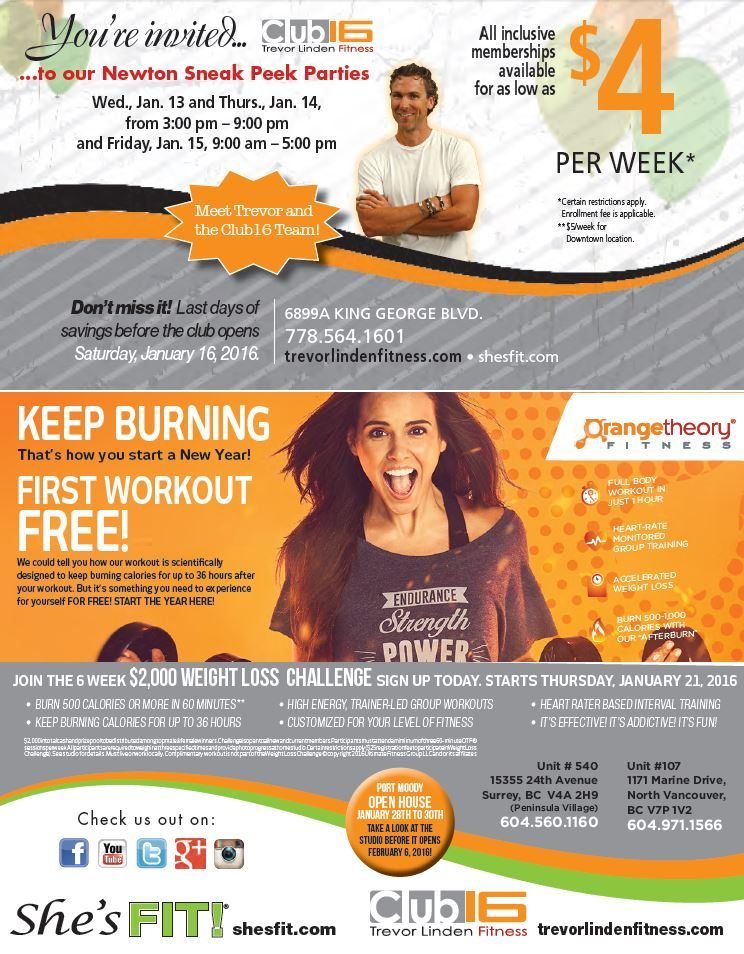
is excited to open its 8th location January 16, 2016 in NEWTON at 8am!
Pre-register at 6899A King George Blvd.
Call 778-564-1601
5 Common Mistakes That Cause New Habits to… Fail…and What to Do About Them!
Depending on where you get your numbers, somewhere between 81 percent and 92 percent of New Year Resolutions fail. Behavior change is hard. No doubt about it. Why is that? What are the biggest reasons new habits fail to stick? And what can we do to make positive changes easier?
PROBLEM 1: Trying to Change Everything at Once.
SOLUTION: Pick one thing and do it well.
The general consensus among behavior change researchers is that you should focus on changing a very small number of habits at the same time. How tiny? Suggested habits include flossing one tooth, doing one pushup per day, or saying “It’s going to be a great day” when you get out of bed in the morning. So, even if you keep your new habits that small, you should work on no more than three habits at a time.
PROBLEM 2: Starting With a Habit That is Too Big.
SOLUTION: Make it so easy you can’t say no.
The most difficult part of a new habit is starting the behavior. It takes a lot of motivation to head to the gym for a workout after an exhausting day at work, but once you actually begin the workout it doesn’t take much willpower to finish it. For this reason, one of the best things you can do for building a new behavior is to start with a remarkably small habit. New habits should be non-threatening. Start with a behavior that is so small it seems easy and reasonable to do it each day. Want to do 50 pushups per day? Start with something easy like 5 or 10.
PROBLEM 3: Seeking a Result, Not a Ritual.
SOLUTION: Focus on the behavior, not the outcome.
Nearly every conversation about goals and resolutions is focused on some type of result. What do you want to achieve? How much weight do you want to lose? How much money do you want to save? Naturally, we are outcome focused because we want our new behaviors to deliver new results. Here’s the problem: New goals don’t deliver new results. New lifestyles do. And a lifestyle is not an outcome, it is a process. For this reason, all of your energy should go into building better rituals, not chasing better results. If you want a new habit, you have to fall in love with a new ritual.
PROBLEM 4: Not Changing Your Environment.
SOLUTION: Build an environment that promotes good habits.
I have never seen a person consistently stick to positive habits in a negative environment. You can frame this statement in many different ways: It is nearly impossible to eat healthy all of the time if you are constantly surrounded by unhealthy food. We rarely admit it (or even realize it), but our behaviors are often a simple response to the environment we find ourselves in.
In fact, you can assume that the lifestyle you have today (all of your habits) is largely a product of the environment you live in each day. The single biggest change that will make a new habit easier is performing it in an environment that is designed to make that habit succeed. If your environment doesn’t change, you probably won’t either.
PROBLEM 5: Assuming Small Changes Don’t Add Up.
SOLUTION: Get one percent better each day.
If you listen to nearly anyone talk about their goals, you’ll hear them describe the minimum that they want to achieve. “I want to lose at least 20 pounds before summer.”
The underlying assumption is that your achievements need to be big to make a difference. Because of this, we always talk ourselves into chasing a big habit. “If I want to lose at least 20 pounds, I need to start busting my butt and working out for 90 minutes a day!”
If you look at your current habits, however, you’ll see a different picture. Nearly every habit you have today, good or bad, is the result of many small choices made over time. It is the repeated pattern of small behaviors that leads to significant results. Each day we make the choice to become one percent better or one percent worse, but so often the choices are small enough that we miss them.
If you’re serious about building a new habit, then start with something small. Start with something you can stick with for good. Then, once you’ve repeated it enough times, you can worry about increasing the intensity.
Build the behavior first. Worry about the results later.
By James Clear Source: http://jamesclear.com/habits-fail
Sneaker Savvy
Consumers are faced with so many options that the task of choosing a pair of shoes has become increasingly complicated and confusing, not to mention expensive. By attaining a good working knowledge of athletic footwear, you’ll help yourself find the perfect pair of affordable shoes.
GUIDELINES FOR BUYING SHOES
When shopping for athletic shoes, the first step is deciding what type you need. If you engage in a specific activity two or three times each week, such as running, walking, tennis, basketball or aerobics, you’ll want a shoe designed specifically for that sport. Multipurpose shoes such as cross trainers may be a good alternative for those who participate in several sports or activities, such as cardiovascular and weight training, in a single workout.
When purchasing shoes for a specific sport or fitness activity, consider your foot type. People with high-arched feet tend to require greater shock absorption than those with a normal-arched foot. People with high- arched feet also suffer from lateral instability and are more prone to ankle sprains. Conversely, people with low-arched (“flat”) feet require shoes with less cushioning, but greater support in the mid-foot region and better heel control.
TEST THE SHOES FOR BASIC STABILITY:
• Grab the shoe at the ball and heel. Bend the shoe from front
to back. The shoe should bend right near the ball of the
foot, because that’s your foot’s natural hinge point, but the
shoe must not be too flexible.
• At the heel of the shoe, find the “heel counter,” a stiff
cup sewn into the back of the shoe to provide heel support.
• Squeeze this cup into the shoe. It should be very stiff and not
easily collapse inward.
• Hold the shoe at each end and twist it. A shoe that offers
good lateral support to the foot should only twist a little bit.
• Place the thumb of one hand inside the heel of the shoe and
the other hand under the sole of the shoe near the heel.
Compress your hands together to feel the amount of
cushioning offered by the shoe. The more compression you
feel, the more shock absorption the shoe offers.
FIT TIPS
• General recommendations include get fitted for footwear
toward the end of the day. It’s not unusual for an individual’s
foot to increase by half a shoe size during the course of a
single day. However, if you plan to exercise consistently at a
specific time, consider getting fitted at that exact time.
• Allow a space up to the width of your index finger between
the end of your longest toe and the end of the shoe. This
space will accommodate foot size increases, a variety of socks
and foot movement within the shoe without hurting your
toes.
• The ball of the foot should match the widest part of
the shoe and you should have plenty of room for your toes
to wiggle without experiencing slippage in the heel.
• Shoes shouldn’t rub or pinch any area of your foot or ankle.
Rotate your ankles when trying on shoes, and pay attention
to the sides of your feet and the top of your toes, common
areas for blisters.
Source: http://www.acefitness.org/acefit/fitness-fact-article/2633/sneaker-savvy/
Healthy Transformations
Blueberry French Toast

Ingredients:
- ¼ tsp vanilla extract
- ¼ tsp Stevia (optional)
- 2 tsp protein powder, vanilla
- ½ cup egg whites, Liquid
- 1 Tbl milk, low-fat, 2%
- 3 slices bread (rye,
pumpernickel,100% whole
grain, flourless) - 1 Tbl orange juice
- 2 ½ tsp oil, high oleic
safflower - 1 cup blueberries
PREPARATION:
Set bread & blueberries aside.
Mix egg whites with remaining ingredients. Place bread into mixture and
l et soak for about 1 minute.
Pour the bread and rest of mixture into oiled skillet. Cook over medium
heat, flip over when golden brown.
Scoop excess liquid onto bread so it won’t burn, continue to cook other
side.
Serve with blueberries on top.
Per serving: 422 calories, 32g protein, 14g total fat, 42g carbohydrates.
Source: Healthy Transformations Recipes









